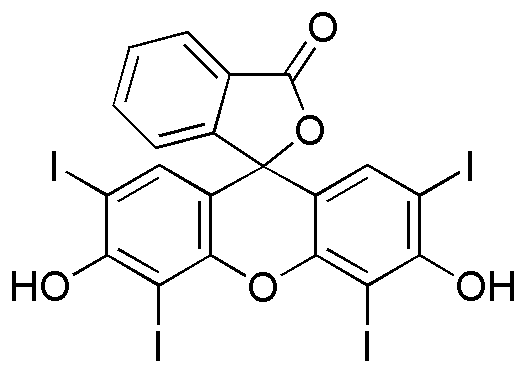Erythrosin B is widely utilized in research focused on:
- Food Industry: Commonly used as a food dye, it enhances the visual appeal of products like candies and beverages, ensuring compliance with food safety regulations.
- Biomedical Research: Employed in fluorescence microscopy, it aids in visualizing cellular structures, making it invaluable for researchers studying cell biology and pathology.
- Pharmaceuticals: Utilized in drug formulation, it helps in tracking drug delivery systems, providing insights into the efficacy of medications.
- Environmental Monitoring: Acts as a tracer in studies of water quality, helping scientists detect pollutants and assess ecological health.
- Cosmetics: Incorporated in cosmetic formulations, it provides color while being safe for skin application, appealing to manufacturers focused on consumer safety.
General Information
Properties
Safety and Regulations
Applications
Erythrosin B is widely utilized in research focused on:
- Food Industry: Commonly used as a food dye, it enhances the visual appeal of products like candies and beverages, ensuring compliance with food safety regulations.
- Biomedical Research: Employed in fluorescence microscopy, it aids in visualizing cellular structures, making it invaluable for researchers studying cell biology and pathology.
- Pharmaceuticals: Utilized in drug formulation, it helps in tracking drug delivery systems, providing insights into the efficacy of medications.
- Environmental Monitoring: Acts as a tracer in studies of water quality, helping scientists detect pollutants and assess ecological health.
- Cosmetics: Incorporated in cosmetic formulations, it provides color while being safe for skin application, appealing to manufacturers focused on consumer safety.
Documents
Safety Data Sheets (SDS)
The SDS provides comprehensive safety information on handling, storage, and disposal of the product.
Product Specification (PS)
The PS provides a comprehensive breakdown of the product’s properties, including chemical composition, physical state, purity, and storage requirements. It also details acceptable quality ranges and the product's intended applications.
Certificates of Analysis (COA)
Search for Certificates of Analysis (COA) by entering the products Lot Number. Lot and Batch Numbers can be found on a product’s label following the words ‘Lot’ or ‘Batch’.
*Catalog Number
*Lot Number
Certificates Of Origin (COO)
This COO confirms the country where the product was manufactured, and also details the materials and components used in it and whether it is derived from natural, synthetic, or other specific sources. This certificate may be required for customs, trade, and regulatory compliance.
*Catalog Number
*Lot Number
Safety Data Sheets (SDS)
The SDS provides comprehensive safety information on handling, storage, and disposal of the product.
DownloadProduct Specification (PS)
The PS provides a comprehensive breakdown of the product’s properties, including chemical composition, physical state, purity, and storage requirements. It also details acceptable quality ranges and the product's intended applications.
DownloadCertificates of Analysis (COA)
Search for Certificates of Analysis (COA) by entering the products Lot Number. Lot and Batch Numbers can be found on a product’s label following the words ‘Lot’ or ‘Batch’.
*Catalog Number
*Lot Number
Certificates Of Origin (COO)
This COO confirms the country where the product was manufactured, and also details the materials and components used in it and whether it is derived from natural, synthetic, or other specific sources. This certificate may be required for customs, trade, and regulatory compliance.


